|
Click pictures for a larger version.
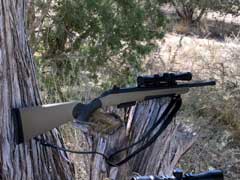
Matt's Ruger American Scout Rifle in 450 Bushmaster.
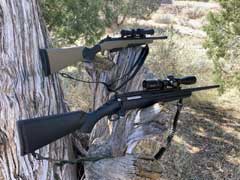
Matt's Ruger American Scout rifles in 450 Bushmaster (top) and 5.56/223
(bottom).


Matt's 7.62x39 "Rooskout".

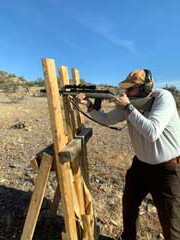

Matt puts the Rooskout through its paces.
|
|
Back in the mid-80s, Col.
Jeff Cooper, founder of the American Pistol Institute (API),
later renamed Gunsite,
conceptualized a light, compact, bolt action rifle, chambered in
.308 Win. The
specifications ultimately were finalized on an overall package
of less than 40” in total length and that weighed less than 7
pounds, with both iron and optical sights attached. Col. Cooper did a good bit of writing on this subject, and
worked with the Gunsmithy, the local on-site gunsmith at
Gunsite, to develop some prototypes. In the late 1980s, Steyr
commercialized a great Scout rifle with a few innovative
features which included a spare magazine storage in the stock
and a folding bipod in the forearm just to name a few.
In 2011, working with Ed Head, long time Gunsite
Rangemaster and pupil of Col. Cooper, Ruger
introduced a Gunsite Scout Rifle, based on their Model 77 action.
This rifle was available in both right-handed
and left-handed
models and in various
calibers. Still
other calibers have since been introduced recently as well (i.e.
350 Legend, 450 Bushmaster).
It is interesting that 35 or so years later,
the Scout rifle still has a place in the gun rack, truck, safe,
and out in the field, for many shooters.
It is testimony to the wisdom of Col. Cooper and his
understanding of the practicality of a light, compact and
powerful rifle. Equally
interesting to the author is that there appears to be two
similar, but yet different schools of the thought on the Scout
rifle. One, the
purist, adheres to the exact specifications laid out by Col.
Cooper in his writings, such as action, caliber, dimensions,
etc. The other, what I call the modernist, believes that the
concept of a Scout rifle is just that, a concept, and that what
matters is the spirit of what Col. Jeff Cooper proposed: a
light, handy, compact, powerful rifle.
This modernist school of thought allows for the evolution
of different options, calibers, sights, and actions, that
aren’t typically considered by the purist.
In discussing this with my good friend Ed Head, who knew
Col. Cooper fairly well, having taken his classes, taught for (and
with) him, and working for him as Operations Manager at Gunsite
for many years, I have come to the personal belief that what
Col. Cooper was trying to instill was the concept of the Scout
Rifle, not the hard and fast definition.
There is a lot to be said for a light, compact, handy
rifle in a caliber that is powerful enough to take down large
game. This opens up the type of action (bolt, lever, semi-auto),
caliber, and optics to a plethora of options available in
today’s market, which may or may not have been available to
Col. Cooper early on.
This brings me to the topic of this article.
The ideals of a modern take on the Scout Rifle
concept…the “Pseudo Scout”. The use of the word pseudo is intentional, and, in a
some ways, in deference to the purists, and their belief that a
Scout Rifle can only be one true to the Col. Cooper's specified
configuration.
Around the same time that Ruger introduced
its Gunsite Scout Rifle, it also introduced a budget level
hunting rifle, named the American.
This rifle was designed in-house, on a new action, with a
lightweight free floated stock.
It was presented in typical Ruger fashion, with various
calibers and configuration permutations.
As this rifle started to gain acceptance, data began to
show that, no matter what caliber the rifles were chambered in,
they were very, very accurate.
They were certainly more accurate than a budget-level
rifle typically is expected to be.
With the Marksman Trigger allowing for the user to adjust
the trigger pull between 3 and 5 pounds, the rifle allowed for
some personalization.
Following an article by Ed Head a year or so
ago, I decided to pursue the Pseudo Scout concept and form my
own opinions. I
started with stock, out of the box, Ruger American rifles
chambered in different calibers. Already owning a Gunsite Scout Rifle in 308 Win and in 5.56
NATO, I decided to try this concept out in calibers different
than the ones I am already familiar with. The first rifle I decided to build was one that I had owned
for a few years and had picked up at a fund raising event for
the Ruger Owners & Collectors Society (ROCS), chambered in
450 Bushmaster.
Skinner
Sights has developed, and commercialized, a full length
Picatinny rail for the Ruger American Rifle.
The rail is fitted with an aperture rear sight and an AR
A2-style post front sight.
A few holes need to be drilled and tapped in the rifle by
a qualified gunsmith in order to install it properly.
Once installed, it allows for mounting of a scope
anywhere on the rifle, including in a forward Scout-like
position. I acquired one of these rails and brought it, along with the
rifle, to Robar, in Phoenix, AZ (Robar unfortunately closed down
in mid-2019). I had
them install the rail and, while they had the rifle, I asked
them to NP3 coat the bolt for an even smoother operation and to
perform their texturing feature on the grip and forearm.
Since the rifle was in an FDE color, I had them leave
their texturing in black, allowing for a nice contrast in colors
that were aesthetically pretty cool.
I was able to acquire one of Leupold’s
fine FXII 2-8 Scout scopes and, along with a set of their low
mount rings, I installed it in the forward Scout position. Other than the caliber, this rifle meets all the criteria
defined for the Scout rifle.
It is light, handy and certainly quite powerful.
Sometime last year, in 2020, I decided to
build another Pseudo Scout, also on based on the Ruger American
rifle. This time, I
opted for one that was chambered in 7.62x39, a caliber that has
been proven for decades to hit hard yet allow for chambering in
a short action. I used the Ruger American Ranch rifle variation, which uses
Ruger Mini-30 magazines. These
are still readily available in 5, 20 and 30-round
configurations. I
again reached out to Andy Larsson at Skinner Sights and
purchased one of his full-length rails with the front and rear
sights. Since Robar
had gone out of business, I sought out Dave Fink, of Finks’
Custom Gunsmithing, and had him install it for me.
I was able to acquire another Leupold Scout scope, in
this case a Gunsite custom edition in a fixed 2.5X power that
was promptly mounted and bore sighted.
I added a Simply
Rugged Alaskan Sling to complete the package, and ended up
with yet another very light, handy, compact, and powerful rifle.
I was able to sight it in quite easily as it quickly
proved to be a very reliable and accurate rifle with any
ammunition I could feed it. It did not matter if it was steel cased, brass cased, FMJ or
JHP, premium or not, it all worked great, fed great, and was
incredibly accurate. I
recently had an opportunity to use it on the Military Crest, an
outdoor simulator at Gunsite, with steel targets from 200 to 300
yards which proved to be no match for the rifle.
About a month or two ago, while perusing the
Covid pandemic limited inventory of used guns at Murphy’s, a
gun shop in Tucson, AZ, I came across a Ruger American Compact
chambered in .223. This
rifle was one of the early ones, all black, with the 5-shot
rotary magazine. It had an 18” barrel and a 12.5” LOP. It just spoke to me and and I knew, deep in my soul, that I
had to make it into a Pseudo Scout.
So it, too, underwent the Skinner Sight rail treatment,
again installed by David Fink.
However, scout scopes were quite a bit more challenging
to find during the pandemic which resulted in tightness in
supply of pretty much everything gun related.
I was able to find a lightly used 2-7 Vortex scout scope
on one of the popular auction sites. After mounting, bore sighting and sighting in, the rifle was
ready to go. It proved its accuracy and served me well at one of
Gunsite’s outdoor simulators, the Vlei, keeping up with the
other shooters who were all using modern sporting rifles (MSRs)
of various calibers and configurations.
The 7.62x39 rifle, which I have
affectionately nicknamed "Rooskout", and the 223 rifle
have become my go-to rifles when I am out and about in the
Arizona desert. Both rifles are in very popular calibers which will prove
useful when ammunition supplies in the country start to
stabilize again and become more readily available.
In the meantime, I have enough on hand of both to get me
through the crisis. Worst
case, the barter economy is always a viable option as well, as
this is ammo that would be easier to find, and barter for, if it
ever comes to that. Both
rifles have proven to be very accurate at short and long
distances (out to 300 yards) and, depending on the need, are
serving me well in town, out in the country, in the mountains,
or in the deserts of Arizona.
So
there you have it, the Pseudo Scout is a valid concept.
It works, and works quite well.
The Ruger American rifle is a great,
and affordable,
base rifle. Coupled
with Skinner Sights’ full length Picatinny rail and a good
quality scout scope, one could do a lot worse for an all-around,
lightweight, easy handling, powerful rifle.
And this, right there, in my opinion, meets all of what
Col. Jeff Cooper had intended with this concept.
Matt
Olivier
  
Got something to say about this article?
Want to agree (or disagree) with it? Click the following link to
go to the GUNBlast Feedback Page.
|
|
Click pictures for a larger version.
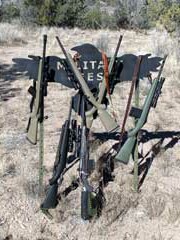
A variety of Scout Rifles at home: Gunsite.
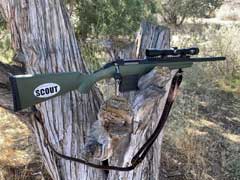

Ed Head's 308 Scout Rifle, built by Robar.
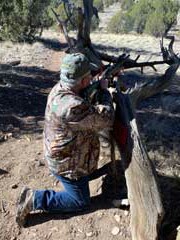

Ed Head shooting his Robar 308 Scout Rifle.
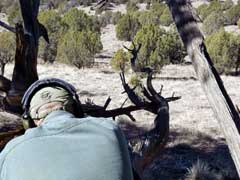

Matt shoots as Valerie Andersen and Rob Leahy observe.
|
![]()